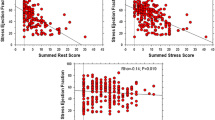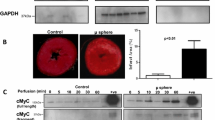Abstract
Changes in serum myosin light chain I (MLCI) due to elective percutaneous transluminal coronary angioplasty (PTCA) were studied after PTCA (0, 8 and 48 hours) in 57 patients with old myocardial infarction (MI group) and 20 patients with angina pectoris (AP group). The AP group showed no increase after PTCA. In contrast, in the MI group there were 16 patients in whom MLCI at 48 hours was increased by 1.0 ng/m/ or more (MI1 group) and another group of 41 patients who showed no increase in MLCI (MI2 group). The MI1 group had a significantly higher incidence of (1) non-Q wave myocardial infarction (62.5% vs. 17.1%, p< 0.01), (2) 99% stenosis of a coronary artery (50.0% vs. 12.2%, p< 0.01), and (3) redistribution in a hypoperfusion area found in the delayed image of resting thallium-201 (201Tl) myocardial scintigraphy (85.7% vs. 15.8%, p< 0.01). The left ventricular ejection fraction (LVEF) was significantly improved in the MI1 group, 3 to 4 months later (from 0.49±0.12 to 0.58±0.l 1, p< 0.01), in contrast to the patient of MI2 group who did not show any improvement. The AP group was not considered to have a bulk of myocardium impaired enough to show a release of MLCI due to PTCA-associated transient coronary occlusion. In the MI1 group, however, MLCI was probably released from the chronically underperfused, but still salvageable, portion of the myocardium. This is consistent with the improvement in LVEF observed 3 to 4 months after the relief of severe coronary stenosis. These findings suggest that the MI1 group had a large amount of “hibernating myocardium.”
Similar content being viewed by others
References
Isobe M, Nagai R, Ueda S, et al: Quantitative relationship between left ventricular function and serum cardiac myosin light chain I levels after coronary reperfusion in patients with acute myocardial infarction.Circulation 76: 1251–1261, 1987
Trahern CA, Gere JB, Krauth GH, et al: Clinical assessment of serum myosin light chains in the diagnosis of acute myocardial infarction.Am J Cardiol 41: 641–645, 1978
Heyndrickx GR, Millard RW, McRitchie RJ, et al: Regional myocardial functional and electrophysiological alterations after brief coronary artery occlusion in conscious dogs.J Clin Invest 56: 978–985, 1975
Geft IL, Fishbein MC, Ninomiya K, et al: Intermittent brief periods of ischemia have a cumulative effect and may cause myocardial necrosis.Circulation 66: 1150–1153, 1982
Heyndrickx GR, Amano J, Kenna T, et al: Creatine kinase release not associated with myocardial necrosis after short periods of coronary artery occlusion in conscious baboons.J Am Coll Cardiol 6: 1299–1303, 1985
Spadaro JJ, Ludbrook PA, Tiefenbrunn AJ, et al: Paucity of subtle myocardial injury after angioplasty delineated with MB CK.Cathet Cardiovasc Diag 12: 230–234, 1986
Pauletto P, Piccolo D, Scannapieco G, et al: Changes in myoglobin, creatine kinase and creatine kinase-MB after percutaneous transluminal coronary angioplasty for stable angina pectoris.Am J Cardiol 59: 999–1000, 1987
Oh JK, Shub C, Ilstrup DM, et al: Creatine kinase release after successful percutaneous transluminal coronary angioplasty.Am Heart J 109: 1225–1231, 1985
Komamura K, Naka M, Nanto S, et al: Release of myocardial enzymes into coronary sinus by brief ischemia during percutaneous transluminal coronary angioplasty.Med J Osaka Police Hosp 10: 31–39, 1986 (in Japanese)
Suehiro M, Naruse H, Fukuda Y, et al: Fundamental and clinical evaluation of IRMA for serum cardiac myosin light chain I.Jpn J Nucl Med 27: 1183–1190, 1990 (in Japanese)
Sandier H, Dodge HT: The use of single plane angiocardiograms for the calculation of left ventricular volume in man.Am Heart J 75: 325–334, 1968
Khaw BA, Gold HK, Fallon JT, et al: Detection of serum cardiac myosin light chains in acute experimental myocardial infarction: radioimmunoassay of cardiac myosin light chains.Circulation 58: 1130–1136, 1978
Smitherman TC, Dycus DW, Richards EG: Dissociation of myosin light chains and decreased myosin ATPase activity with acidification of synthetic myosin filaments: possible clues to the fate of myosin in myocardial ischemia and infarction.J Mol Cell Cardiol 12: 149–164, 1980
Nixon JV: Southwestern Internal Medicine Conference, Non-Q-wave myocardial infarction.Am J Med Sci 292: 173–181, 1986
Gibson RS, Beller GA, Gheorghiade M, et al: The prevalence and clinical significance of residual myocardial ischemia 2 weeks after uncomplicated non-Q wave infarction: a prospective natural history study.Circulation 73: 1186–1198, 1986
Wahl JM, Hakki AH, Iskandrian AS, et al: Scintigraphic characterization of Q wave and non-Q-wave acute myocardial infarction.Am Heart J 109: 769–775, 1985
Mori T, Yamabe H, Yoshida H, et al: The significance of resting thallium-201 delayed SPECT for assessing viability of infarcted regions—comparison with exercise thallium-201 SPECT—.Jpn Circ J 55: 99–108, 1991
Rozanski A, Berman DS, Gray R, et al: Use of Thallium-201 redistribution scintigraphy in the preoperative differentiation of reversible and nonreversible myocardial asynergy.Circulation 64: 936–944, 1981
Iskandrian AS, Hakki AH, Kane SA, et al: Rest and redistribution thallium-201 myocardial scintigraphy to predict improvement in left ventricular function after coronary artery bypass grafting.Am J Cardiol 51: 1312–1316, 1983
Suryapranta H, Serruys PW, Beatt K, et al: Recovery of regional myocardial dysfunction after successful coronary angioplasty early after a non-Q wave myocardial infarction.Am Heart J 120: 261–269, 1990
Braunwald E, Rutherford JD: Reversible ischemic left ventricular dysfunction: evidence for the “hibernating myocardium”.J Am Coll Cardiol 8: 1467–1470, 1986
Cohen M, Charney R, Hershman R, et al: Reversal of chronic ischemic myocardial dysfunction after transluminal coronary angioplasty.J Am Coll Cardiol 12: 1193–1198, 1988
Murry CE, Jennings RB, Reimer KA: Preconditioning with ischemia: a delay of lethal cell injury in ischemic myocardium.Circulation 74: 1124–1136, 1986
Deutsch E, Berger M, Kussmaul WG, et al: Adaptation to ischemia during percutaneous transluminal coronary angioplasty. Clinical, hemodynamic, and metabolic features.Circulation 82: 2044–2051, 1990
Miura T, Goto M, Urabe K, et al: Does myocardial stunning contribute to infarct size limitation by ischemic preconditioning?Circulation 84: 2504–2512, 1991
Author information
Authors and Affiliations
Rights and permissions
About this article
Cite this article
Tanaka, H., Gotoh, K., Yagi, Y. et al. Increase in serum cardiac myosin light chain I associated with elective percutaneous transluminal coronary angioplasty in patients with ischemic heart disease. Ann Nucl Med 6, 261–268 (1992). https://doi.org/10.1007/BF03164664
Received:
Accepted:
Issue Date:
DOI: https://doi.org/10.1007/BF03164664




